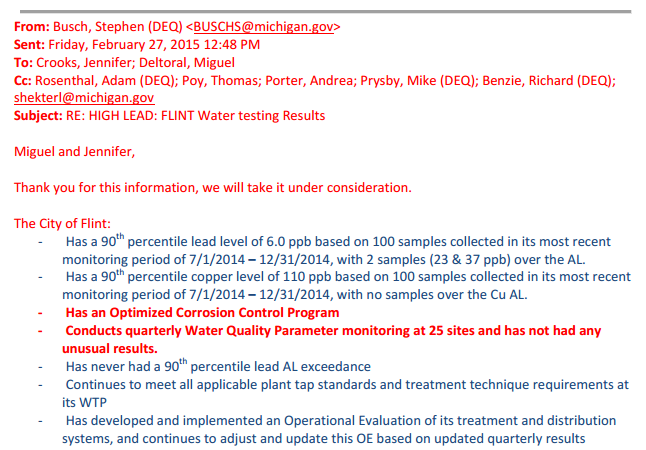DID FLINT OFFICIALS KNOWINGLY CONTAMINATE THEIR RESIDENCE?
- Sixth Gate Online News Agency

- Jan 20, 2016
- 5 min read
According to Michigan State Governors office; Gov. Snyder submits letter of appeal to the office of President Barack Obama in which the federal government denied the City of Flint a major disaster declaration, If the city of Flint could receive a disaster declaration than that could potentially bring much needed resources to help the residence of Flint, Michigan.
“The situation in Flint is a disaster and in need of a federal declaration,” Snyder said. “This situation poses an imminent and long-term threat to the people of Flint. We appreciate the support of the White House through the earlier emergency declaration. But additional federal resources are needed for the work that must be done.”
Governor Snyder’s statement is followed by him stating “this disaster is similar in scope to a flood, given that qualities within the water over a long period of time damaged the city’s infrastructure in ways that are not immediately detectable. The problems will contribute to years -- and potentially decades -- of health problems and economic loss as well as require repairs to the infrastructure that neither the city, county nor state has the capacity to carry out, said Gov. Snyder
On March 7, 2014 Darnell Earley, Flint Emergency Manager denies Detroit Water and Sewer Plant’s offer of The City of Flint to continue buying water from their treated water facility; Earley responds back to a letter stating that “The City of Flint will no longer be purchasing water off their facility and instead will be obtaining their water supply from the Flint River; “
Not long after, State environmental regulators approve permits to the city of flint in regards to the city being able to switch their water supply from Detroit Water and Sewer Plant unto The Flint River until 2016 when the KWA pipeline would be finished however a few week later on April 25, 2014 The City of Flint made the switch from their water supply From Lake Huron/Detroit Water and Sewer Plant to The Flint River.
Approximately a month later the residence of the city started noticing and complaining about the taste, smell and discoloration of their water supply, many of the residents stated they were sick from consuming the water;
Later in 2014 Flint water was tested and results came back the cities water supply was positive for E-Coli in response to the test results Flint officials issued an advisory to their residents to boil their water prior to consumption and/or use.
After officials attempted to treat the cities water supply for E-Coli The Michigan Department of Environmental Quality found unacceptable levels of “Total Trihalomethanes: TTHM is a byproduct in which is incorporated into the waters chlorination and disinfection process; A few days later Officials hold a press conference to tell the residence of flint that the drinking water is safe.
The University of Michigan finds that some samples of the city’s water was contaminated with “Lead” however at the time researchers thought this may have been an isolated issue; as a result of this issue the university decided to shut down numerous of drinking fountains.
The same week the university found the drinking water to be contaminated with lead, city council members hold a meeting with residence where the concerned residence asked officials to stop utilizing the river’s water and to switch back over to Detroit; Darnell Earley states to the residence “NO the city will hire a water treatment consultant to attempt to fix the problems with the water; Officials than stated that switching back to Detroit would cost an estimate of $12 million or more in water cost.
A later test of the city’s water determines that the city’s water supply contained 104 parts per billion which according to EPA regulation the most amount of lead allowed in water is no more than 15 parts per billion which is a violation against the safe drinking water act.
According to the United States Environment Protection Agency “The Environmental Protection Agency (EPA) identifies contaminants to regulate in drinking water; The Agency sets regulatory limits for the amounts of certain contaminants in water provided by public water systems. These contaminant standards are required by the Safe Drinking Water Act (SDWA). EPA protects public health by implementing the SDWA provisions while working with states, tribes, and many other partners”
Once the EPA gains knowledge of such contaminations the EPA questions Flint Officials about the process in which they treat their water supply; Flint officials respond stating they are treating the water correctly; In an email response to the EPA; Stephen Busch of MDEQ says “Flint has an optimized corrosion control plan” according to the EPA water treatment plants are suppose to add chemicals like phosphates to prevent corrosion, The EPA later discovers that flint was not treating their water for corrosion.
One of Flint’s long-time residence Lee Anne Walters found out that her child has been contaminated with lead poisoning, City officials immediately cut off the service line and connected the family’s home to a neighbor’s garden hose.
The Coalition for Clean Water decides to file suite in regards to flints water supply problem. The EPA later expresses further concern to flint officials about the cities drinking water containing enormous amount of lead.
During a Michigan Radio interview with MDEQ’s Brad Wurfel states, “Anyone who is concerned about lead in the drinking water in Flint can relax, It does not look like there is any broad problem with the water supply freeing up lead as it goes to homes, Wurfel said.
According to the U.S. EPA; Lead is a naturally occurring element found in small amounts in the earth’s crust. While it has some beneficial uses, it can be toxic to humans and animals causing of health effects. Lead is particularly dangerous to children because their growing bodies absorb more lead than adults do and their brains and nervous systems are more sensitive to the damaging effects of lead. Babies and young children can also be more highly exposed to lead because they often put their hands and other objects that can have lead from dust or soil on them into their mouths. Children may also be exposed to lead by eating and drinking food or water containing lead or from dishes or glasses that contain lead, inhaling lead dust from lead-based paint or lead-contaminated soil or from playing with toys with lead paint.
Adults may be exposed to lead by eating and drinking food or water containing lead or from dishes or glasses that contain lead. They may also breath lead dust by spending time in areas where lead-based paint is deteriorating, and during renovation or repair work that disturbs painted surfaces in older homes and buildings. Working in a job or engaging in hobbies where lead is used, such as making stained glass, can increase exposure as can certain folk remedies containing lead. A pregnant woman’s exposure to lead from these sources is of particular concern because it can result in exposure to her developing baby.
The City of Flint has received two class action lawsuits in regards to the contamination of the city’s water supply approximately give or take about a dozen of residence both children and adults have been effected by lead poisoning which can cause long term health, nerve and other issues with-in those who have become effected by the water’s lead poisoning.






















































Comments